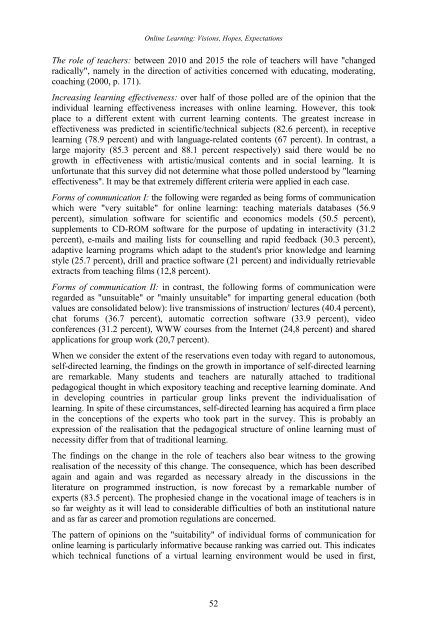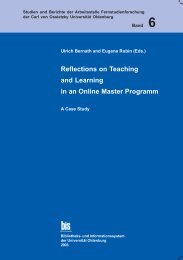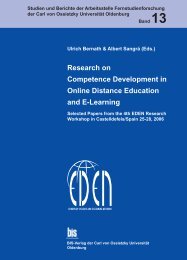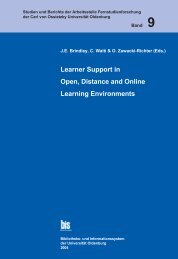Distance Education in Transition - Master of Distance Education ...
Distance Education in Transition - Master of Distance Education ...
Distance Education in Transition - Master of Distance Education ...
You also want an ePaper? Increase the reach of your titles
YUMPU automatically turns print PDFs into web optimized ePapers that Google loves.
Onl<strong>in</strong>e Learn<strong>in</strong>g: Visions, Hopes, Expectations<br />
The role <strong>of</strong> teachers: between 2010 and 2015 the role <strong>of</strong> teachers will have "changed<br />
radically", namely <strong>in</strong> the direction <strong>of</strong> activities concerned with educat<strong>in</strong>g, moderat<strong>in</strong>g,<br />
coach<strong>in</strong>g (2000, p. 171).<br />
Increas<strong>in</strong>g learn<strong>in</strong>g effectiveness: over half <strong>of</strong> those polled are <strong>of</strong> the op<strong>in</strong>ion that the<br />
<strong>in</strong>dividual learn<strong>in</strong>g effectiveness <strong>in</strong>creases with onl<strong>in</strong>e learn<strong>in</strong>g. However, this took<br />
place to a different extent with current learn<strong>in</strong>g contents. The greatest <strong>in</strong>crease <strong>in</strong><br />
effectiveness was predicted <strong>in</strong> scientific/technical subjects (82.6 percent), <strong>in</strong> receptive<br />
learn<strong>in</strong>g (78.9 percent) and with language-related contents (67 percent). In contrast, a<br />
large majority (85.3 percent and 88.1 percent respectively) said there would be no<br />
growth <strong>in</strong> effectiveness with artistic/musical contents and <strong>in</strong> social learn<strong>in</strong>g. It is<br />
unfortunate that this survey did not determ<strong>in</strong>e what those polled understood by "learn<strong>in</strong>g<br />
effectiveness". It may be that extremely different criteria were applied <strong>in</strong> each case.<br />
Forms <strong>of</strong> communication I: the follow<strong>in</strong>g were regarded as be<strong>in</strong>g forms <strong>of</strong> communication<br />
which were "very suitable" for onl<strong>in</strong>e learn<strong>in</strong>g: teach<strong>in</strong>g materials databases (56.9<br />
percent), simulation s<strong>of</strong>tware for scientific and economics models (50.5 percent),<br />
supplements to CD-ROM s<strong>of</strong>tware for the purpose <strong>of</strong> updat<strong>in</strong>g <strong>in</strong> <strong>in</strong>teractivity (31.2<br />
percent), e-mails and mail<strong>in</strong>g lists for counsell<strong>in</strong>g and rapid feedback (30.3 percent),<br />
adaptive learn<strong>in</strong>g programs which adapt to the student's prior knowledge and learn<strong>in</strong>g<br />
style (25.7 percent), drill and practice s<strong>of</strong>tware (21 percent) and <strong>in</strong>dividually retrievable<br />
extracts from teach<strong>in</strong>g films (12,8 percent).<br />
Forms <strong>of</strong> communication II: <strong>in</strong> contrast, the follow<strong>in</strong>g forms <strong>of</strong> communication were<br />
regarded as "unsuitable" or "ma<strong>in</strong>ly unsuitable" for impart<strong>in</strong>g general education (both<br />
values are consolidated below): live transmissions <strong>of</strong> <strong>in</strong>struction/ lectures (40.4 percent),<br />
chat forums (36.7 percent), automatic correction s<strong>of</strong>tware (33.9 percent), video<br />
conferences (31.2 percent), WWW courses from the Internet (24,8 percent) and shared<br />
applications for group work (20,7 percent).<br />
When we consider the extent <strong>of</strong> the reservations even today with regard to autonomous,<br />
self-directed learn<strong>in</strong>g, the f<strong>in</strong>d<strong>in</strong>gs on the growth <strong>in</strong> importance <strong>of</strong> self-directed learn<strong>in</strong>g<br />
are remarkable. Many students and teachers are naturally attached to traditional<br />
pedagogical thought <strong>in</strong> which expository teach<strong>in</strong>g and receptive learn<strong>in</strong>g dom<strong>in</strong>ate. And<br />
<strong>in</strong> develop<strong>in</strong>g countries <strong>in</strong> particular group l<strong>in</strong>ks prevent the <strong>in</strong>dividualisation <strong>of</strong><br />
learn<strong>in</strong>g. In spite <strong>of</strong> these circumstances, self-directed learn<strong>in</strong>g has acquired a firm place<br />
<strong>in</strong> the conceptions <strong>of</strong> the experts who took part <strong>in</strong> the survey. This is probably an<br />
expression <strong>of</strong> the realisation that the pedagogical structure <strong>of</strong> onl<strong>in</strong>e learn<strong>in</strong>g must <strong>of</strong><br />
necessity differ from that <strong>of</strong> traditional learn<strong>in</strong>g.<br />
The f<strong>in</strong>d<strong>in</strong>gs on the change <strong>in</strong> the role <strong>of</strong> teachers also bear witness to the grow<strong>in</strong>g<br />
realisation <strong>of</strong> the necessity <strong>of</strong> this change. The consequence, which has been described<br />
aga<strong>in</strong> and aga<strong>in</strong> and was regarded as necessary already <strong>in</strong> the discussions <strong>in</strong> the<br />
literature on programmed <strong>in</strong>struction, is now forecast by a remarkable number <strong>of</strong><br />
experts (83.5 percent). The prophesied change <strong>in</strong> the vocational image <strong>of</strong> teachers is <strong>in</strong><br />
so far weighty as it will lead to considerable difficulties <strong>of</strong> both an <strong>in</strong>stitutional nature<br />
and as far as career and promotion regulations are concerned.<br />
The pattern <strong>of</strong> op<strong>in</strong>ions on the "suitability" <strong>of</strong> <strong>in</strong>dividual forms <strong>of</strong> communication for<br />
onl<strong>in</strong>e learn<strong>in</strong>g is particularly <strong>in</strong>formative because rank<strong>in</strong>g was carried out. This <strong>in</strong>dicates<br />
which technical functions <strong>of</strong> a virtual learn<strong>in</strong>g environment would be used <strong>in</strong> first,<br />
52





